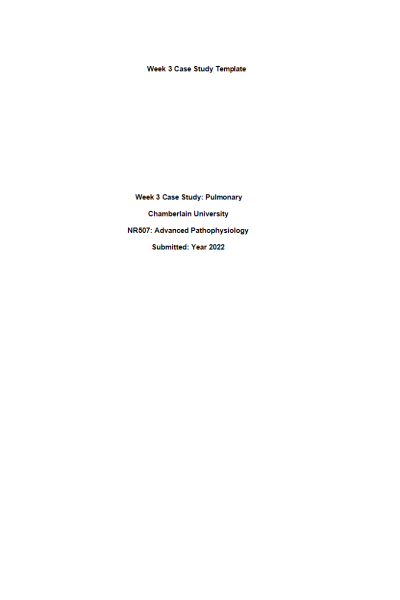NR 507 Week 3 Case Study; Pulmonary
-
$20.00
| Institution | NR 507 Advanced Pathophysiology |
| Contributor | Mireille |
Case Study Scenario
Chief Complaint
A.C., is a 61-year old male with complaints of shortness of breath.
History of Present Illness
A.C. was seen in the emergency room 1 week ago for an acute onset of mid-sternal chest pain. The event was preceded with complaints of fatigue and increasing dyspnea for 3 months, for which he did not seek care. He was evaluated by cardiology and underwent a successful and uneventful angioplasty prior to discharge. Despite the intervention, the shortness of breath has not improved. Since starting cardiac rehabilitation, he feels that his breathlessness is worse. The cardiologist has requested that you, his primary care provider, evaluate him for further work-up. Prior to today, his last visit with your practice was 3 years ago when he was seen for acute bronchitis and smoking cessation counseling.
Past Medical History
- Hypertension
- Hyperlipidemia
- Atherosclerotic coronary artery disease
- Smoker
Family History
- Father deceased of acute coronary syndrome at age 65
- Mother deceased of breast cancer at age 58.
- One sister, alive, who is a 5 year breast cancer survivor.
- One son and one daughter with no significant medical history.
Social History
- 35 pack-year smoking history; he has cut down to one cigarette at bedtime following his cardiac intervention.
- Denies alcohol or recreational drug use
- Real estate agent
Allergies
- No Known Drug Allergies
Medications
- Rosuvastatin 20 mg once daily by mouth
- Carvedilol 25 mg twice daily by mouth
- Hydrochlorothiazide 12.5 mg once daily by mouth
- Aspirin 81mg daily by mouth
Review of Systems
- Constitutional: Denies fever, chills or weight loss. + Fatigue.
- HEENT: Denies nasal congestion, rhinorrhea or sore throat.
- Chest: + dyspnea with exertion. Denies productive cough or wheezing. + Dry, nonproductive cough in the AM.
- Heart: Denies chest pain, chest pressure or palpitations.
- Lymph: Denies lymph node swelling.
General Physical Exam
- Constitutional: Alert and oriented male in no apparent distress.
· Vital Signs: BP-120/84, T-97.9 F, P-62, RR-22, SaO2: 93%
· Wt. 180 lbs., Ht. 5'9"
HEENT
- Eyes: Pupils equal, round and reactive to light and accommodation, normal conjunctiva.
- Ears: Tympanic membranes intact.
- Nose: Bilateral nasal turbinates without redness or swelling. Nares patent.
- Mouth: Oropharynx clear. No mouth lesions. Dentures well-fitting. Oral mucous membranes dry.
Neck/Lymph Nodes
- Neck supple without JVD.
- No lymphadenopathy, masses or carotid bruits.
Lungs
- Bilateral breath sounds clear throughout lung fields. + Bilaterally wheezes noted with forced exhalation along with a prolonged expiratory phase. No intercostal retractions.
Heart
- S1 and S2 regular rate and rhythm, no rubs or murmurs.
Integumentary System
- Skin cool, pale and dry. Nail beds pink without clubbing.
Chest X-Ray
- Lungs are hyper-inflated bilaterally with a flattened diaphragm. No effusions or infiltrates.
Spirometry
Case Study Questions
Pathophysiology & Clinical Findings of the Disease
- Are the spirometry results consistent with obstructive or restrictive pulmonary disease? What is the most likely pulmonary diagnosis for this patient?
- Explain the pathophysiology associated with the chosen pulmonary disease.
- Identify at least three subjective findings from the case which support the chosen diagnosis.
- Identify at least three objective findings from the case which support the chosen diagnosis.
Management of the Disease
*Utilize the required Clinical Practice Guideline (CPG) to support your treatment recommendations.
- Classify the patient's disease severity. Is this considered stable or unstable?
- Identify two (2) "Evidence A" recommended medication classes for the treatment of this condition and provide an example (drug name) for each.
- Describe the mechanism of action for each of the medication classes identified above.
- Identify two (2) "Evidence A" recommended non-pharmacological treatment options for this patient.
| Instituition / Term | |
| Term | Year 2022 |
| Institution | NR 507 Advanced Pathophysiology |
| Contributor | Mireille |






























